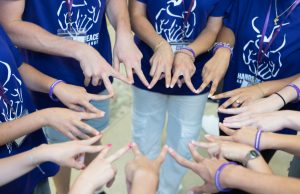At Langley Memorial Hospital in Langley, B.C., one can scrub in and get behind some of the hospital’s most cutting-edge equipment following years of schooling and medical training or simply by being among its leading donors.
The hospital’s staff recently hosted 29 corporate and individual donors for an interactive demonstration of some of the facility’s surgical equipment and an opportunity to perform a mock procedure.
The behind-the-scenes experience was part of a first-time effort in end-of-year gift stewardship, according to Vivian Smith, executive director of Langley Memorial Hospital Foundation (LMHF).
The concept of a special donor event toward the end of the year came as the foundation began looking at #GivingTuesday and year-end asks, Smith said. As opposed to simply sending out asks, it occurred to LMHF’s team that a special thank you to donors would be appropriate to kick off the season. “It seemed to me that, if you say ‘thank you’ first, it’s a stronger ask,” said Smith. The foundation’s leaders chose to highlight hospital equipment during the event, as upgrading equipment has been a focus of the 2015-2016 fiscal year. It’s expected that $1.635 million will be raised this fiscal year ending on March 31, 2016, Smith said, with $500,000 earmarked for equipment purchases. During 2014-2015, $1.238 million was raised, according to Smith, with a far smaller portion going toward equipment.
The hospital’s chief of surgery supported the idea and a team of eight surgeons and nurses spent more than two hours following a daily rotation taking individual donors who contributed at least $5,000 and corporate donors who gifted $10,000 or more around four stations: orthopedic, laparoscopic, head and neck and gastrointestinal.
The hands-on tour served as an opportunity to provide donors with a new perspective of the hospital as well as engage with medical staff, observe new equipment in use and become aware of pieces of equipment that are aging out, Smith said.
Feedback from the event was positive from both sides, Smith said, with donors leaving impressed by the hospital’s level of technology and the commitment of staff and the surgical team gaining perspective on hospital finances and the community. The foundation intends to use pictures from the event in future campaigns and publications, such as its semi-annual newsletter in March, Smith said.
In addition to providing a learning experience for donors and staff, the tour resulted in material that is more engaging than the typical picture of donors and foundation staff with a giant check, Smith said. “My personal philosophy is that fundraisers, we are facilitators, we are bridge builders,” Smith said. “We need to be in the wings and doing something like this to let our clinical team and donors take center stage.”
LMHF intends to continue with a “thank you” philosophy in year-round campaigns, perhaps spotlighting healthcare initiatives in the community. “I don’t think it can be overstated,” Smith said of the value of saying “thank you.” “Now it is a relationship, not a transaction.”
Though “please” and “thank you” are two phrases many grow up reciting, some organizations are flipping the order, saying “thank you” before going forward with a request. This practice has become especially true during the year-end holiday season as organizations reflect on the past year and look toward future goals.
Fundraisers at Oakland University (OU) in Rochester, Mich., have been thanking members of the school’s Black and Gold Loyalty Society with a special year-end invitation to a basketball game or theatrical performance in recent years, according to Angie Schmucker, the school’s interim campaign director. There are approximately 2,500 members of The Black and Gold Loyalty Society, donors who made contributions for three or more consecutive years.
The first such event was put together at the last minute and attracted a few dozen donors to a basketball game, Schmucker said. The event has increased in popularity during the past three or four years, Schmucker said, with hundreds now attending the offerings and the school’s entire theater being reserved for a performance exclusively for donors. A dinner with staff has since been included to allow staff and donors to better connect, Schmucker said.
OU sends regular appreciation emails as gifts arrive, said Kelly Brault, the university’s interim executive director of planned and annual giving. Stewardship picks up during the end of the year. The university held a special event during the school’s homecoming festivities this past September for donors who had given $10,000. OU’s president is filming a variety of videos for donors, alumni, faculty and students looking at the successes of 2015 and the goals of 2016. A president’s report providing similar information also goes out to major donors and thank-you letters are sent around Thanksgiving to express appreciation to donors for planned gifts.
“Maybe we’re more specialized during the holidays, but we try to have multiple touch points throughout the year,” Brault said.
Schmucker and Brault said that the school’s 5-percent increase in donor retention from 2013-2014 to 2014-2015 could be partially attributed to efforts such as videos from the president, which are new, and other stewardship efforts. Schmucker declined to provide the school’s current retention rate.
Texas Methodist Foundation (TMF), headquartered in Austin, Texas, is entering new territory by incorporating video into end-of-year stewardship, according to Justin Gould, vice president of development. TMF filmed videos with leaders and service recipients from three Houston-based nonprofits receiving TMF funding, detailing the work the organization does and why TMF’s support is important.
“The fourth quarter, for us, is critical,” Gould said. “We really do hone-in on our communications in the fourth quarter and holiday period and really try to focus on the outcomes of what gifts have been made to [the foundation].”
The videos are supplemental to, not a replacement for, more traditional stewardship activities such as face-to-face conversations and letters, Gould said. TMF is still in the working stages of developing a separate but associated ask for donations and volunteerism in coordination with the videos, Gould said.
Video is a medium that made sense for TMF as it provides an opportunity to demonstrate the impact of the foundation through action, Gould said. It is important to try to connect the right message with the right audience, segmenting and targeting stewardship messages to reach specific donor groups.
“I think that people receive messages in different ways,” Gould said. “The better-tailored approach we have, the more likely we are to connect with that donor…The video, for us, is the piece that they can hear a direct ‘thank you.’”
Fundraising staff members were forced to get more creative in their efforts during the recession, according to John Winnett, executive vice president of the Association for Fundraising Professionals’ Foundation for Philanthropy. Nonprofit leaders took a cue from their peers in the for-profit sector who were looking for means of staying in contact with customers. For nonprofits, customers are donors, Winnett said, and thus a mix of year-round touch points including birthday and holiday cards and face-to-face meetings increased in popularity.
Fundraisers from larger nonprofits have been successful for several years in taking a more creative approach with such touch points, with fundraisers at smaller and medium-sized organizations now catching up, Winnett said. Organizations servicing children or adults with disabilities have used hand-written notes and pieces of art from clients to add a personal feel to touch points. Other organizations have eschewed traditional mailings for short, emailed videos depicting clients’ thankfulness that can be both inexpensive and effective. “People give money to people,” Winnett said. “Make it very relevant, very emotional and very personal.”
Winnett advises organizations to think strategically and plot future steps when looking to create touch points such as year-end thank you messages. “Your most effective nonprofits will continue to build on stewardship plans, well thought-out and strategic plans, that include development, executive and even operations teams,” said Winnett. Other tips for touch points include:
- Just say “thank you.” Fundraisers do not need to include an ask in every message. “It’s a touch point, everything doesn’t have to be a solicitation,” Winnett said;
- Focus on key contributors during the holidays. Do not look at the holidays as an opportunity to expand donor bases; and,
- All in moderation. Do not bombard donors with messages.
Beth Ann Locke has fundraised for institutions across the U.S. and Canada, currently serving as director of advancement at Simon Fraser University in Burnaby, B.C. She concurred with Winnett’s emphasis on getting creative. “What we need to do is make sure that the gesture we are offering is respectful and ties back to the mission,” Locke said. “Cards are great to do, but I also think we want to make gestures that are as personal as we can for donors.”
Nonprofits can make thank-you cards as opposed to store-bought, Locke said, and include a picture of the organization’s mission being advanced. For major-gift donors, having the donor’s relationship manager write a note inside a card and sign it is an easy way to add a personal touch. For larger donors, messages and signatures from the organization’s executives can also be meaningful.
At past positions, Locke has used videos posted on a private YouTube channel with students thanking clients by name to provide a unique, quick sign of appreciation. “I think more reporting on impact and more thanking are actually going to connect the donor more to the organization,” Locke said. NPT












